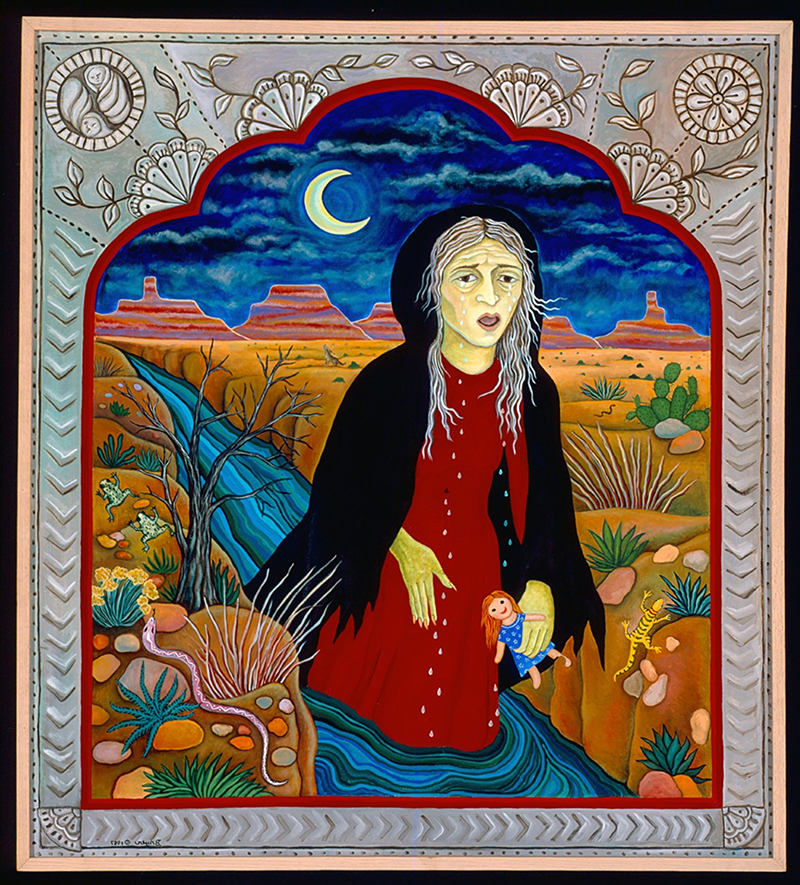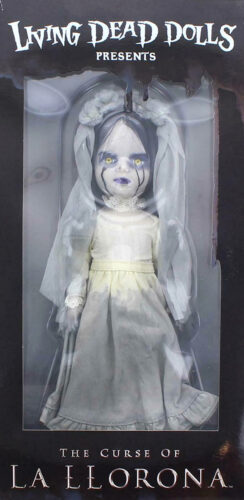She is a woman of intrigue, tragedy and mystery. She is a legend that has been frightening children for hundreds of years. She is as much a part of Spanish American culture as its music, its food and its lyrical language. She is past and present, real and imagined. She is the famous — or infamous — La Llorona.
Many versions
As with most folk stories, there are many versions of the La Llorona story. In most versions, she was a young mother who faced a horrible choice regarding her children.

La Llorona painting by Diana Bryer.
In some accounts, her husband has betrayed her and so she drowns her children in a ditch to seek revenge for his deceitfulness. In other stories, her lover threatens to leave her if she keeps her children and so she drowns them to keep him. The tale takes other forms, depending on the teller, the place and the time in history.
Regardless of the variation of her story, the heartbroken mother regrets her act of filicide so much that she forever haunts our ditchbanks, searching for her children, weeping with cries of anguish and meriting the name La Llorona, The Weeping Woman.
While most New Mexicans have heard the story of La Llorona, there are some who claim to have actually seen or heard the weeping mother, with accounts they are often happy to share. Who are these eye-witnesses? Where were they when their encounters occurred? And what did they see, hear or feel? Inquiring, nervous minds want to know — especially as we prepare to celebrate Halloween!
Encounters
While New Mexicans of every age have heard the haunting cries of La Llorona by their ditchbanks, children from the ages of 6 to 16 seem most vulnerable to believing the nocturnal legend. The young are at an age when they are still discovering the world around them, sorting out the real from the imagined on their journey to adulthood.

Ditch at La Llorona Park, Las Cruces, N.M.
People, especially kids, have encountered La Llorona in locations in every corner of New Mexico. Of course, those who see or hear La Llorona are usually near a ditch, a river, a lake or some other body of water.
A 14-year-old girl claimed to have seen La Llorona many times behind her family’s house near the Rio Mora in Mora County. On another occasion, a teenage boy and his friends were camping near a lake in Santa Rosa when they heard crying and saw a dark shadow near the water. Recalling the incident years later, they remembered that they quickly forgot about camping and “left early.”
In another sighting, several teenage friends went driving by a river. Parking their vehicle, they sat in the dark, absorbed in telling ghost stories to each other, when the transmission in their car suddenly popped into drive, although nobody had touched it. As with the campers in Santa Rosa, these teens “hightailed it home.”
Of course, you didn’t need to leave home to see La Llorona. One summer night a 12-year-old girl and her 6-year-old brother decided to sleep on the trampoline in their backyard, which happened to border a ditchbank. Sometime in the night they spotted a blue light floating above the ditch. Although they did not hear a sound, the sister and brother had seen enough. They quickly grabbed their blankets, ran into their house and never slept outside again.
Clara Garcia, our esteemed editor and publisher of the News-Bulletin, says when she was about 6 years old she was sure that La Llorona tried to get into her bedroom through the window every night. For protection, Clara slept with blankets over her head for about two years.
“Needless to say, she never found me,” Garcia said.
Scaring others
As with every good ghost story, La Llorona’s tale is told to scare friends and foes alike. One adult remembers being about 10 years old when some of his friends first told him about La Llorona.
As he walked home after a Little League game one evening, the boy had to walk along the Hondo River. Remembering what his friends had told him about La Llorona, he says, “When it started to get dark I ran the rest of the way home!”
Clara Garcia remembers that she and two of her childhood friends would try to scare each other with tales of La Llorona.
“We would use our recess time in elementary school telling tales of this folklore,” even making up their own versions to make the original story even scarier. Years later, at their Belen High School class’s 30th reunion, Clara and her friends still remembered frightening each other, although they laugh about it now.
Another adult recalls growing up with several siblings on West Picard Avenue in Belen. They were told that La Llorona was responsible for the blood-curdling cries coming from the west mesa each night. Actually, a family on the mesa raised noisy peacocks, but the kids were told it was La Llorona — and they believed it.
Children who were new to New Mexico were most vulnerable to tales of La Llorona. A boy visiting Belen from Chicago was told the story before being led along the ditch near Bernard Avenue. Local kids scared the wits out of the boy by having someone dress in black and run along the ditchbank. Now an adult with a family of his own, this poor victim is still probably telling his children about his hair-raising misadventure in Belen.
In order to prevent them from playing near dangerous ditches, parents often scare their children with stories of a ditch witch who supposedly inhabits our acequias. Such an evil entity should not be confused with La Llorona who, despite her horrible deeds, has never been deemed a witch.

A La Llorona doll.
Threats
Many adults made good use of La Llorona when they wanted to get children to behave. One woman’s grandmother told her and her siblings that if they didn’t go to sleep on time La Llorona would take them away.
Another woman remembers when her rather sadistic aunts babysat for her, they would tell her she had better behave because her mother was really La Llorona.
“I tell you it scared the you-know-what out of me!” she remembers.
In another instance, a teenager and a group of his friends in Albuquerque’s North Valley took beer from one of their father’s stock and went drinking by a ditch one evening.
“It was very dark and kind of scary,” he now recalls, “but we all felt so cool.”
Suddenly, a lady yelled behind them, “What do you think you’re doing?”
One of the boys’ mothers had followed him after she heard him sneak out a window. Sure that the voice they heard was La Llorona’s, the boys scattered in all directions.
“It was a couple of years until I snuck out again.”
Other places, other tales
La Llorona is a famous ghost story about a young woman in New Mexico, but there are many similar stories in the region and beyond.
Some say they hear the cries of a lost bride searching for her lover at night in White Sands. Local residents claimed to have heard an Indian princess’s forlorn cries near Belen’s Old Town. The ghost of a woman, murdered by her former lover, has been seen along the banks of the Rio Puerco in northern Socorro County.
But La Llorona is the most celebrated of these supernatural visions. She is remembered in paintings, poems, songs, books, a figurine, a talking doll, a Mexican cartoon, a one-woman show, a two-act play, a movie, an opera and her own Facebook page. A city park in Las Cruces is even named in her memory.
Yet the best way to remember La Llorona is not through works of art or entertainment. The best way to remember her is to simply walk by a ditch on a dark, lonely night.
If the wind is blowing just right and you are of the right frame of mind, you might well hear her mournful cries and be among the thousands who have encountered La Llorona, an eerie yet enduring part of our New Mexico culture.
Readers who have more tales of La Llorona are welcome to share them with the author ([email protected]) for a future La Historia article likely to be called, “More Tales of La Llorona.”
(La Historia del Rio Abajo is a regular column about Valencia County history written by members of the Valencia County Historical Society since 1998.
Opinions expressed in this and all columns of La Historia del Rio Abajo are the authors’ alone and not necessarily those of the Valencia County Historical Society or any other group or individual.)

Richard Melzer, guest columnist
Richard Melzer, Ph.D., is a retired history professor who taught at The University of New Mexico–Valencia campus for more than 35 years. He has served on the board of directors of the Valencia County Historical Society for 30 years; he has served as the society’s president several times.
He has written many books and articles about New Mexico history, including many works on Valencia County, his favorite topic. His newest book, a biography of Casey Luna, was published in the spring of 2021.
Those interested in joining the Valencia County Historical Society should contact Dr. Melzer at [email protected].



